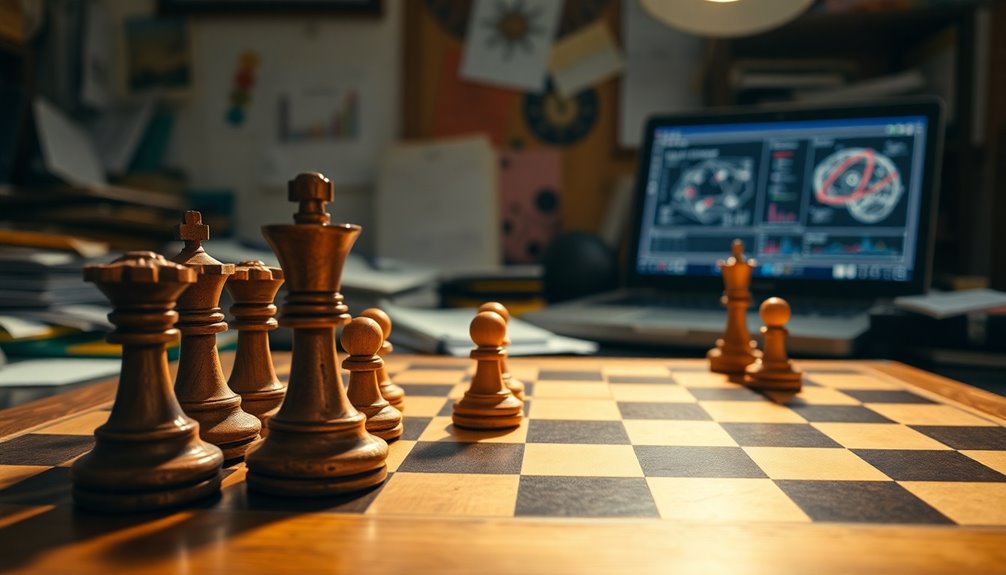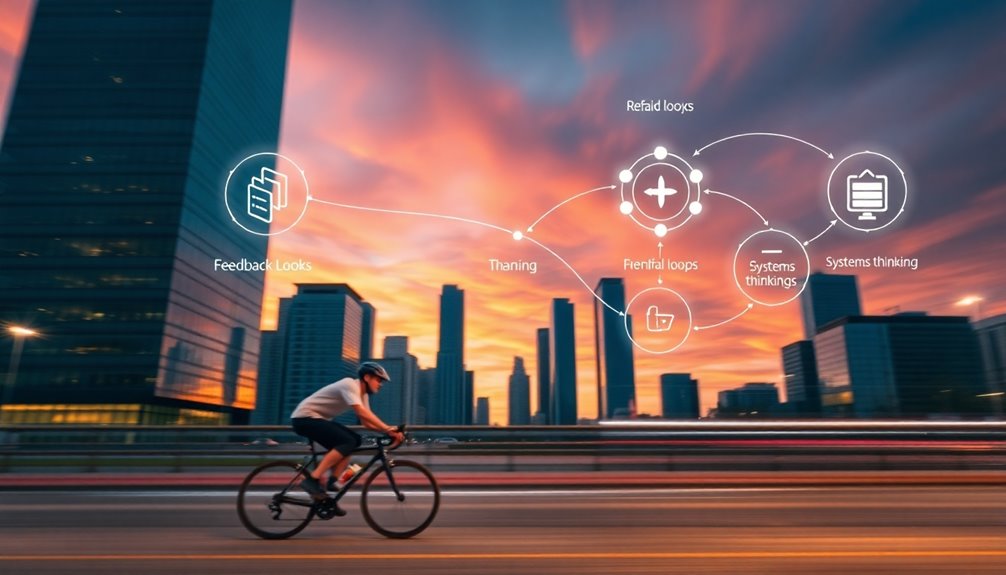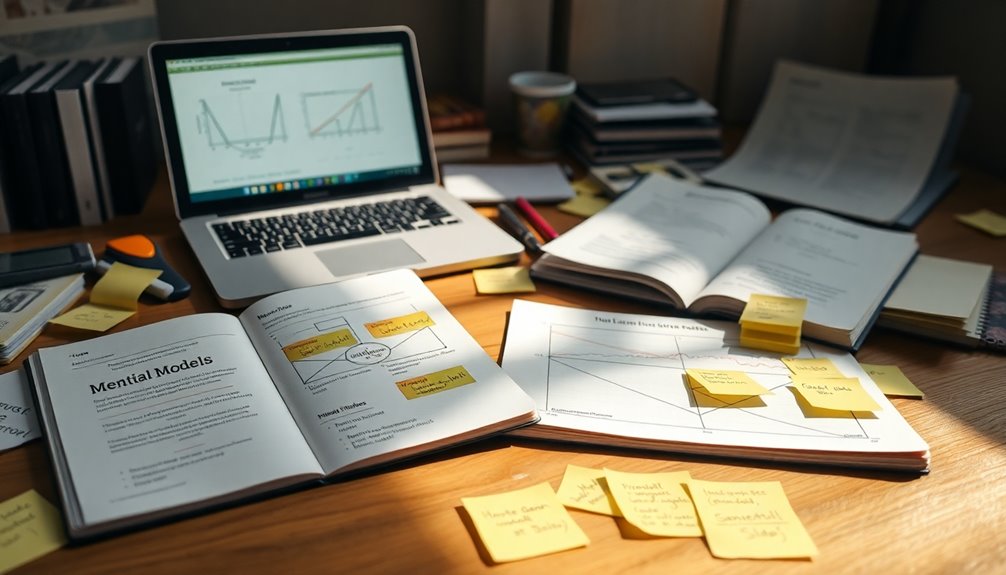To make better decisions and understand complex systems, you should learn key mental models like supply and demand, game theory, entropy, velocity, and opportunity cost. These tools help you analyze market trends, strategic interactions, natural decay, purposeful progress, and trade-offs. Mastering these models allows you to navigate uncertainty effectively. If you keep exploring, you’ll uncover how these concepts can transform your thinking and problem-solving in everyday life.
Key Takeaways
- Understand the Law of Supply and Demand to grasp market dynamics and how prices influence behavior.
- Use Game Theory to analyze strategic interactions and predict others’ actions in decision-making.
- Recognize Entropy to appreciate natural disorder and the importance of effort in maintaining order.
- Apply the Opportunity Cost concept to evaluate trade-offs and make smarter choices.
- Focus on Velocity and Change to ensure purposeful movement aligned with goals, avoiding wasted effort.
Supply and Demand

Supply and demand are fundamental concepts that explain how markets function. You need to understand that supply shows how much producers can produce and offer, while demand reflects how much consumers want to buy. The law of demand states that when prices go up, demand drops; when prices fall, demand rises. Conversely, the law of supply indicates that higher prices motivate producers to supply more, while lower prices discourage them. Price elasticity measures how sensitive demand or supply is to price changes—some products react sharply, others less so. External shifts in supply or demand can change this balance, influencing market dynamics. Additionally, understanding projector technology can help consumers make better purchasing decisions in related markets. Recognizing how market equilibrium is affected by external factors helps in predicting market trends and making informed economic choices.
Game Theory

Have you ever wondered how competing businesses or individuals make decisions when their outcomes depend on what others choose? That’s where game theory comes in. It analyzes interactive decisions where each player’s move influences everyone’s results. You consider the players, possible actions, and outcomes, aiming to understand stable strategies — like the Nash equilibrium — where no one benefits from changing their choice alone. In this framework, players are rational and aim to maximize their payoffs, knowing the rules and possible moves. Game theory applies across economics, politics, biology, and more, helping you predict behaviors like bidding in auctions or negotiating deals. By understanding these strategic interactions, you can make smarter decisions, anticipate others’ actions, and navigate complex situations with confidence.
Entropy and Disorder

Just as game theory reveals how strategic decisions depend on others’ actions, the concept of entropy explains how systems naturally tend toward disorder over time. Entropy measures the level of chaos in a system, and according to the second law of thermodynamics, it always increases in isolated systems. This means that without intervention, order will inevitably break down into chaos. You see this daily—ice melts, messes accumulate, and structures decay. Whether in nature, relationships, or your personal space, entropy is constantly working against organization. Maintaining order requires effort; otherwise, disorder takes over. Recognizing this helps you understand why systems tend to become messy or broken unless actively managed. Embracing entropy highlights the importance of effort to sustain stability amid inevitable decay.
Velocity and Change

Understanding velocity as a mental model requires recognizing that it’s more than just moving quickly; it’s about combining speed with clear direction to achieve meaningful progress. You need to focus on both how fast you’re going and where you’re headed. Rapid activity without purpose can lead nowhere, so clarifying your goals and aligning your actions is essential. Velocity emphasizes purposeful movement, helping you avoid wasted effort and burnout. It’s not just about being busy; it’s about deliberate, strategic change. By evaluating whether your efforts move you toward your desired outcomes, you can make smarter decisions during transitions. Recognizing velocity keeps you oriented, preventing you from rushing in the wrong direction and ensuring your momentum builds toward meaningful, sustained progress. Embracing continuous learning and adaptability as part of your mindset can further enhance your ability to adjust your course effectively.
Opportunity Cost

What exactly is opportunity cost, and why should you care about it? Opportunity cost is the value of the option you give up when choosing one thing over another. It’s a critical concept in both personal and business decisions because it helps you evaluate what you’re sacrificing with each choice. This cost can be measured in money, time, happiness, or satisfaction. Understanding opportunity cost allows you to make smarter decisions by weighing the benefits of each option. Whether you’re deciding how to spend your time, money, or resources, knowing the opportunity cost reveals the true trade-offs involved. Recognizing these trade-offs helps you prioritize effectively and avoid regrets about missed opportunities, making your decision-making sharper and more intentional. Additionally, considering opportunity cost in your daily choices can lead to more efficient use of resources and better long-term outcomes. Incorporating AI-powered decision analysis can further enhance your ability to evaluate options objectively and optimize your choices.
Causal Loops and Feedback

When making decisions, it’s important to recognize that many outcomes depend on complex cause-and-effect relationships within systems. Causal loops show how variables influence each other through cause-and-effect links, visualized with causal loop diagrams (CLDs). These diagrams use arrows with positive (+) or negative (–) signs to indicate how one variable impacts another. Feedback loops are closed chains where changes in one variable eventually influence the original, creating reinforcing or balancing effects. Reinforcing loops amplify change, like wealth accumulation or climate warming, leading to exponential growth or decline. Balancing loops counteract change to maintain stability, such as thermostats regulating temperature. Recognizing these loops helps you understand system behaviors, identify leverage points, and anticipate unintended consequences in complex environments. Understanding system dynamics is essential for effectively analyzing and managing complex systems. Additionally, understanding causal relationships can help in designing more effective interventions within these systems. Incorporating insights from system thinking can further enhance your ability to interpret and influence complex interactions.
Probabilistic Thinking

Have you ever contemplated how much more accurate your decisions could be if you accounted for uncertainty rather than assuming outcomes are certain? Probabilistic thinking helps you estimate the likelihood of different results using math and logic, rather than relying on assumptions. It prompts you to consider a full range of possibilities, including unlikely or extreme events. Key questions include “What else might happen?” and “What if we’re wrong?” Bayesian thinking, a core concept, involves updating your beliefs as new information arises. This approach helps you navigate uncertainty confidently, make better predictions, and avoid overconfidence. Whether evaluating risks, forecasting outcomes, or making investment decisions, probabilistic thinking enables you to balance likelihoods and impacts, ultimately improving your decision-making accuracy. Understanding self watering plant pots can also serve as a metaphor for how probabilistic models maintain optimal conditions by constantly adjusting to new data.
Frequently Asked Questions
How Do Mental Models Influence Emotional Decision-Making?
Mental models shape how you process emotions in decision-making. They help you recognize emotional biases and filter perceptions, allowing you to make more balanced choices. When you understand models like emotional filtering or cognitive-emotional coupling, you become aware of how feelings influence your decisions. This awareness enables you to regulate emotions better, embrace complexity, and avoid impulsive reactions, leading to more thoughtful and resilient decisions.
Can Mental Models Change Over Time With New Experiences?
Imagine your mental models as shifting sands beneath your feet. With every new experience, you can reshape or erode them, revealing fresh perspectives. You see, mental models are not fixed; they evolve as you encounter different systems and challenges. By embracing continuous learning and reflection, you actively modify these beliefs, allowing your understanding and decision-making to adapt and grow over time, much like the ever-changing landscape around you.
What Are Common Biases That Distort Mental Models?
You should know that common biases distort your mental models by skewing how you interpret information. Confirmation bias makes you seek evidence that supports your beliefs while ignoring contradictions. Cognitive dissonance causes discomfort, leading you to justify your views. Hindsight bias makes past events seem obvious, and anchoring bias influences your judgments based on initial information. Recognizing these biases helps you develop more accurate, adaptable mental models.
How Do Cultural Differences Shape Mental Models?
Imagine your mental models are like lenses that can turn your world upside down. Cultural differences shape these lenses dramatically, influencing how you see nature, emotions, and social roles. You might interpret behaviors or health issues differently depending on your background. These cultural frameworks act as powerful filters, guiding what you notice, value, or ignore, ultimately shaping your perceptions, decisions, and interactions in ways you might never realize.
How Can I Effectively Learn and Adapt New Mental Models?
To effectively learn and adapt new mental models, you should actively seek diverse sources of knowledge, like interdisciplinary reading and real-world experiences. Practice applying these models in different situations to see how they work. Stay open to feedback and continuously reflect on your assumptions. By embracing change and updating your thinking regularly, you’ll sharpen your decision-making skills and become more adaptable in various contexts.
Conclusion
By mastering these mental models, you can make smarter decisions every day. For example, understanding opportunity cost might lead you to choose learning a new skill over watching TV, boosting your future prospects. Imagine a startup using feedback loops to refine their product—this insight helps them grow faster. When you apply these models, you see the bigger picture, anticipate outcomes, and navigate life’s complexities with confidence. Start practicing them today, and watch your decision-making improve.









